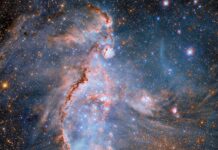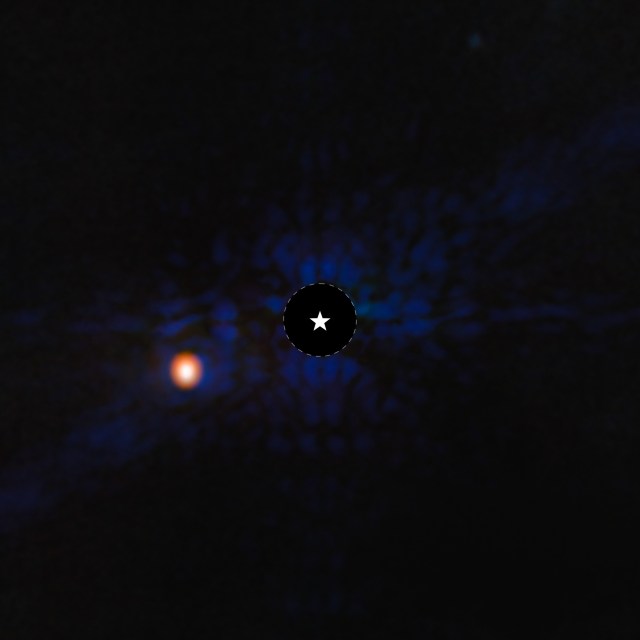New Image of Gas-Giant Exoplanet Epsilon Indi Ab Captured by NASA’s James Webb Space Telescope
NASA’s James Webb Space Telescope has once again demonstrated its exceptional capabilities by capturing a striking image of the gas-giant exoplanet, Epsilon Indi Ab. This image was taken using the telescope’s Mid-Infrared Instrument (MIRI) equipped with a coronagraph. The coronagraph is a device that blocks out the light from a star, allowing astronomers to observe the surrounding areas in greater detail, free from the overwhelming glare of the star itself.
In the released image, a star symbol indicates the position of the host star, Epsilon Indi A. The bright light from this star has been effectively blocked by the coronagraph, creating a dark circle marked with a dashed white line. This blocking is essential for observing the exoplanet, as the light from the host star would otherwise outshine the relatively dim light reflected or emitted by the planet.
Understanding the Technology: Coronagraph and MIRI
The coronagraph is a crucial tool in the field of astronomy, particularly for studying exoplanets. It works by using a small mask to block the light from a star, much like using your hand to shield your eyes from the sun to see something nearby. This allows astronomers to detect and study planets and other objects that are close to the star. Without a coronagraph, the bright light from the star would make it nearly impossible to observe these smaller, dimmer objects.
The Mid-Infrared Instrument (MIRI) on the James Webb Space Telescope is designed to observe light in the mid-infrared part of the spectrum. Mid-infrared light has longer wavelengths than visible light and can reveal details that are otherwise hidden. This capability is particularly useful for studying cool objects like gas-giant exoplanets, which emit most of their light in the infrared.
Epsilon Indi Ab: A Closer Look
Epsilon Indi Ab is a gas-giant exoplanet, meaning it is composed mainly of hydrogen and helium, similar to Jupiter and Saturn in our own solar system. It orbits the star Epsilon Indi A, which is located about 12 light-years away from Earth. This makes it relatively close in astronomical terms, allowing for more detailed study.
The image captured by the James Webb Space Telescope provides valuable data about the planet’s atmosphere, composition, and potential weather patterns. By analyzing the light from Epsilon Indi Ab, scientists can infer the presence of various molecules in its atmosphere, such as water vapor, methane, and carbon dioxide. This information is crucial for understanding the planet’s formation and evolution.
The Significance of This Discovery
The ability to directly image exoplanets like Epsilon Indi Ab is a significant milestone in astronomy. It allows scientists to study these distant worlds in unprecedented detail, providing insights into their atmospheres, climates, and potential habitability. Direct imaging also complements other methods of exoplanet detection, such as the transit method and radial velocity method, by providing additional data that can help confirm and characterize these planets.
Moreover, studying gas-giant exoplanets like Epsilon Indi Ab can shed light on the processes that lead to planet formation. These planets are thought to form in the outer regions of their star systems, where it is cool enough for gases to condense and form massive planets. Understanding these processes can help scientists learn more about the formation of our own solar system and the potential for life elsewhere in the universe.
Reactions from the Scientific Community
The release of this image has generated excitement within the scientific community. Astronomers and researchers have praised the capabilities of the James Webb Space Telescope and the potential for future discoveries.
Dr. Emily Matthews from the Max Planck Institute for Astronomy, who is part of the team studying Epsilon Indi Ab, expressed her enthusiasm: “This image is a testament to the incredible capabilities of the James Webb Space Telescope. The level of detail we can achieve with the MIRI instrument and the coronagraph is truly groundbreaking. We are just beginning to scratch the surface of what we can learn about exoplanets and their environments.”
A Broader Perspective on Exoplanet Research
The study of exoplanets is one of the most exciting and rapidly advancing fields in astronomy. Since the first discovery of an exoplanet in 1992, thousands of these distant worlds have been identified. Each new discovery adds to our understanding of the diversity of planetary systems and the potential for life beyond Earth.
The James Webb Space Telescope, with its advanced instruments and capabilities, is poised to play a crucial role in this ongoing exploration. By capturing detailed images and spectra of exoplanets, it can help answer fundamental questions about their formation, composition, and potential habitability.
Future Prospects and Missions
Looking ahead, the James Webb Space Telescope will continue to observe a variety of exoplanets, from hot Jupiters to potentially habitable Earth-like worlds. Each observation will provide new data that can help refine our models of planet formation and evolution.
In addition to the James Webb Space Telescope, other upcoming missions are set to enhance our understanding of exoplanets. The European Space Agency’s ARIEL mission, scheduled for launch in 2029, will specifically study the atmospheres of exoplanets, complementing the data obtained by Webb. NASA’s Nancy Grace Roman Space Telescope, expected to launch in the mid-2020s, will also contribute to exoplanet research with its wide-field imaging capabilities.
Conclusion
The image of Epsilon Indi Ab captured by NASA’s James Webb Space Telescope is a remarkable achievement that highlights the advanced technology and capabilities of this groundbreaking observatory. By using the MIRI instrument and coronagraph, scientists can study distant exoplanets in unprecedented detail, providing valuable insights into their atmospheres, compositions, and potential for habitability.
As the James Webb Space Telescope continues its mission, we can look forward to many more exciting discoveries that will expand our understanding of the universe and our place within it. The study of exoplanets, in particular, holds the promise of answering some of the most profound questions about the formation of planetary systems and the potential for life beyond Earth.
For those interested in the technical aspects and the broader implications of this discovery, it is worth keeping an eye on future updates and findings from the James Webb Space Telescope and other upcoming missions in the field of exoplanet research. The journey to uncover the mysteries of distant worlds is just beginning, and the possibilities are as vast as the universe itself.
For more Information, Refer to this article.




















![Samsung’s Innovation Sparks Progress in Science and Industry: Quantum Dots How Samsung’s Engineering Feat Became a Catalyst for Scientific and Industry Advancement [Interview on Real Quantum Dots Part 2.]](https://www.hawkdive.com/media/samsung-tvs-and-displays-samsung-quantum-dots-technology-qled-tvs-quantum-dots-experts-interview-par-218x150.jpeg)













